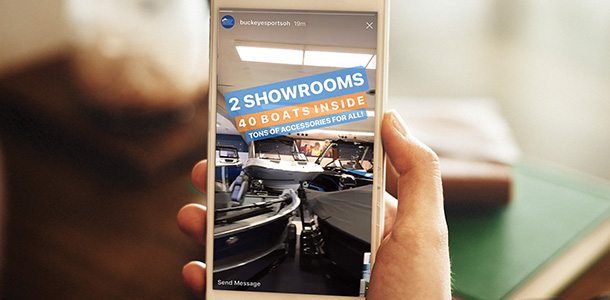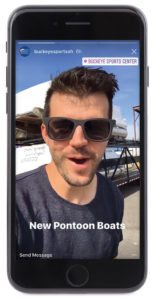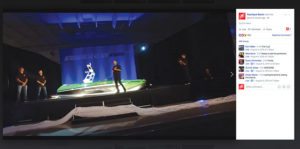Live streaming and story platforms lead social media trends

Social media moves fast. Once you think you’ve got it mastered, there’s a new trend or platform to learn. And your customers are moving right along with it – they want information in the palm of their hand, right in the moment, and what they consider “engaging content” is constantly changing.
One of the major shifts in social media trends in the past few years is the proliferation of live streaming video and story platforms, which both have a high level of organic consumer engagement. Started on Periscope and Snapchat, respectively, these social media tools are now on Instagram and Facebook and available to a wider audience.
And if you think your customer isn’t on these channels or interested in this content, think again – brands are already beginning to see their follower base age up as more and more adults adopt social platforms like Instagram, and if you don’t catch up you will be left behind.
Marine industry marketers have already begun utilizing live video and stories to engage directly with their customer base. In an ever-increasing algorithmic social media landscape, live streaming and stories cut through the noise and get you directly in front of your customer again. That organic feeling (and reach), along with an opportunity to be authentic and raw with your existing and potential customers, is why brands have begun to embrace stories and live streaming.

“Social media rose up as a very organic channel, and then obviously marketing caught up and they’re a huge marketing powerhouse channel now,” said Carrie Waible, president of CW&Co., Regulator Marine’s marketing agency. “But the stories and the live [streaming] allow it to be organic again, that you’re just in a room with someone at that time.”
The content may not be particularly innovative or look completely professional, but it gives followers an opportunity to get an honest and human idea of who you are as a business.
“We know that boat buying is an emotional decision more so than a practical one in many cases,” said Shelby Kirby, director of marketing at Sea Ray Group. “Any way that we can open up the organic feeling that the brand can offer is the biggest opportunity that we see.”
In-between pieces
In stories – either on Snapchat, Instagram or most recently Facebook – photos and video are shared through a story feed for 24 hours; after that time period, the content disappears. Users can upload photos or video they have already taken or capture content directly in the story camera. Content shared in stories, as well as the entire story itself, can be saved for later use, but if you don’t make a point to grab the content within 24 hours it is gone forever.
“Stories see a huge engagement spike. No matter what you’re posting there, it’s just where people want to be on Instagram right now. It’s what they want to see, it’s the next iteration of the entire channel,” said Waible.
Regulator Marine will post sneak peak photos and videos on stories, such as a factory story the brand posted earlier this year. The manufacturer showed viewers how the boat is built without revealing propriety information, coming back to stories the next day and showing how the next day looks in the boatbuilding process.
“When we think about the content we’re putting into stories versus our regular feed, we really want to bring people into a day in the life of a Regulator, wherever that Regulator may be,” said Waible.
This content strategy has paid off for Regulator, as Waible said the manufacturer has seen better engagement with stories than with many of Regulator’s permanent posts.
“We have seen more eyeballs, likes and engagement on certain stories … than we have on other posts that would seem to be in the same content silo,” said Waible, “If I look at product behind the scenes and have us post a photo, if I’ve posted a series of photos through Instagram stories, I see higher engagement there.”
The stories work as a great “in-between piece” that is raw, according to Brent Veverka, director of marketing & media at Buckeye Sports Center, which is of interest to the dealership’s customer base.

“[We are] using that in-between piece to kind of tell people ‘Yes, we are real. We have skin. We breathe. We’re not just a face of a company sharing a bunch of pictures from around the internet. We do this 24-7, it’s in our minds all day long,’” he said. “This past winter, we saw the largest impact – comments, messages sent back to us, overall views, follower count. The percentage of viewers is fantastic to see how many people are tuning into that 24-hour window.”
Stories also signal to your followers, particularly younger ones, that your brand is interested in keeping up with consumer trends and staying in constant contact with your customers.
“It amps up the brand. Even though it lasts for 24 hours, people can go back to your Instagram and they could be a possible follower and follow you, and be more engaged just because you post new content that’s not dated, that’s timed,” said Sara Fahy, digital marketing coordinator for Sea Ray Group.
Teaser content is perfect to post in stories. At the Fort Lauderdale International Boat Show, Sea Ray posted several pre-show teasers, particularly for the L-Class 550 that was debuting at the show.
“We would take short clips of the helm and the captain’s chair, and also of running footage, and post those, but also take still shots and post those as well with fun,” said Fahy. “Most consumers aren’t able to go to FLIBS. So if you can show still shots with scenery in the background and a beautiful picture showcasing part of the boat – like the helm or the sun pad – people want to see that.”
Story posts – specifically Instagram Stories – have been one of the more utilized social media platforms at Nautique in recent months. Content Strategist Shawn Perry said the manufacturer will often format the professional photos and videos Nautique already has specifically for stories.
“It has a sense of urgency with people, so if they see that we’re putting up those few Instagram stories during the day, they’re more likely to interact with that content, because they know it’s not going to be there forever,” he said.
That being said, the manufacturer still shoots plenty of content out in the field, giving followers a behind-the-scenes look at the brand.
“[Followers] don’t necessarily always love that highly produced product-driven messaging. They like to see what the brand does on a day-to-day basis,” said Perry. “For lack of a better term, it’s a bit voyeuristic, but if somebody’s really in touch with your brand, they really want to know what you’re doing on a regular basis.”
Instant connection
In recent years, streaming live video on social media has become very popular, particularly once Facebook (and most recently Instagram) added streaming to their platforms. On Facebook, live videos are archived on your page so followers can watch if they missed the live feed. Instagram recently added the option for users to save their live videos after the fact.

The network will build a live viewership by reaching out to all of your followers and alerting them you are live. It is described by marketers as the most organic reach you can have with followers on social media today, particularly in a world where algorithms and paid boosting rule access.
“For me to post a YouTube video that I spent four days working on editing with voiceovers, shooting content, once I post that as a business page it gets minimal [views] without a boost. With live video, Facebook automatically puts that in the forefront and drives people to watch it as it’s happening. We’ll see almost 20 times the viewers on a live video right away in that 24-hour window than if we just post a video up,” said Veverka. “Live videos are a way to just get traffic instantly much quicker without spending a dime.”
Sea Ray started using live video at the Miami International Boat Show this year to showcase its new models for customers. The first video of the L550 had over 15,000 views in less than 12 hours, and most of the manufacturer’s live videos have had over 10,000 views.
“With Facebook Live, it gives us the opportunity to release that boat to market more quickly than a traditional video shoot that we would produce,” said Kirby. “We still invest money in producing those videos at the brand-quality level, but the walkthroughs are very organic and customers seem to really love them.”
With live video, followers can comment and ask questions as you are filming, which allows for direct contact with the customer. Followers on Sea Ray’s live videos asked about specific features in the boat, and the person conducting the walkthrough was able to answer and display the features in real time.
“You may never show the inside of the cabinetry or the storage beneath the bow or the engine room [during a video walkthrough]. Those are things that are traditionally left out of some of our videos that customers find really interesting and intriguing,” said Kirby.
Buckeye Marine also conducts live walkthroughs of its newest models with a salesperson, almost as if giving a product presentation to a customer at a show or in the showroom.
“We do some edited full-content video but the nice thing about the live setup is you do it and then it’s done. You don’t have to film something and then spend a bunch of time cutting it or uploading it,” said Jay Poole, marketing manager at Buckeye Marine.
The boating industry has a huge advantage when it comes to generating live content that is engaging for followers: all you have to do is add water. Poole will go live when he is able to get out on the water for the first time after the ice goes out and get Buckeye Marine customers excited about nice weather ahead.
Perry noted that the bombardment of marketing messages on social media can be overwhelming for customers, and a candid look at a brand’s products, how they’re made and how they’re used is refreshing for your followers.
“As a brand, it’s important to us to keep our audience feeling inclusive with everything we have going on at Nautique, and live content really does that for us,” he said. “Social [media], for us, is really about inspiring people, so if we can get them that inside look of how much fun it is to own a Nautique, then we’re probably doing our jobs correctly.”
For tips on how to get started using live video and stories, see our “9 tips for getting started in live streaming and stories” article.




